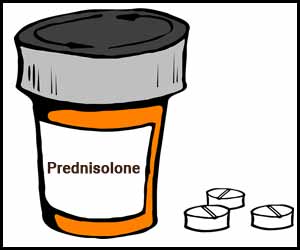- Home
- Editorial
- News
- Practice Guidelines
- Anesthesiology Guidelines
- Cancer Guidelines
- Cardiac Sciences Guidelines
- Critical Care Guidelines
- Dentistry Guidelines
- Dermatology Guidelines
- Diabetes and Endo Guidelines
- Diagnostics Guidelines
- ENT Guidelines
- Featured Practice Guidelines
- Gastroenterology Guidelines
- Geriatrics Guidelines
- Medicine Guidelines
- Nephrology Guidelines
- Neurosciences Guidelines
- Obs and Gynae Guidelines
- Ophthalmology Guidelines
- Orthopaedics Guidelines
- Paediatrics Guidelines
- Psychiatry Guidelines
- Pulmonology Guidelines
- Radiology Guidelines
- Surgery Guidelines
- Urology Guidelines
Low-dose prednisolone substantially improves pain and function in hand OA

ATLANTA --Osteoarthritis is a common joint disease commonly referred to as "wear and tear" of the joints. It most often affects middle-age to elderly people. It may involve the entire joint including cartilage, joint lining, ligaments, and bone and is a cause of disability and pain in the patients. Hand osteoarthritis (OA) is a prevalent joint disease with high disease-burden in need of effective therapeutic options.
It has been found in a new study that a six-week treatment with low-dose oral prednisolone substantially improves pain and decreases signs of inflammation in patients with painful hand osteoarthritis. The research has been presented at the 2019 ACR/ARP Annual Meeting (Abstract #1760).
While studies have previously shown that synovial inflammation is often present in people with hand OA and is the main determinant of both pain and disease progression, there is still some uncertainty about how to effectively treat it. This randomized, double-blind, placebo-controlled trial looked at both efficacy and safety for short-term, low-dose prednisolone used to treat hand OA.
"Hand Osteoarthritis is a common musculoskeletal disease, with a substantial disease-burden in the form of hand pain, functional disability, reduced grip strength and reduced quality of life. Currently, there is an unmet need for effective therapies for this disease. While several therapeutic options for hand OA are available to alleviate symptoms, the efficacy of these treatments is modest at best," says Féline Kroon, MD, a rheumatologist in training at Leiden University Medical Centre in the Netherlands and the study's lead author. "In this trial, we set out to investigate the efficacy and safety of prednisolone based on observations from previous research that local inflammation seems to play a role in the disease and maybe a potential target for treatment."
The trial enrolled patients with signs of synovial inflammation and who met the American College of Rheumatology criteria for painful hand OA. Patients with four or more osteoarthritic nodes involving interphalangeal joints, one or more interphalangeal joint with soft tissue swelling or erythema, and one or more positive power Doppler signal or synovitis of grade two or higher were eligible. Key exclusion criteria for the trial were patients who had chronic inflammatory rheumatic diseases, psoriasis, use of immune-modulating drugs within 90 days before baseline or predominant thumb-based pain.
The researchers randomized eligible patients who had visual analogue scale evidence of finger pain (30 mm or more), and patients who flared upon nonsteroidal anti-inflammatory drug washout (20 mm or more) to receive either prednisolone 10 mg daily for six weeks or a placebo. This was followed by a two-week prednisolone taper, then six weeks without study medications. Outcomes were assessed at two, four, six, eight and 14 weeks.
The trial's primary endpoint was visual analogue scale finger pain at week six in the intention-to-treat analysis. The secondary clinical endpoints included fulfilment of the Osteoarthritis Research Society International (OARSI) responder criteria, Australian/Canadian Hand OA Index (AUSCAN) pain and function, Functional Index for Hand OA (FIHOA), visual analogue scale patient global assessment, the Medical Outcomes Study's Short-Form 36 and grip strength. Imaging endpoints for the trial included both ultrasound evidence of synovitis and positive power Doppler signal. Ninety-two people were enrolled in the trial. The average age was 63 years, and 79 per cent of the participants were women. The enrolled group were split evenly with half receiving prednisolone and the other half receiving a placebo. In each of these two groups, 42 completed the trial. At week six, 33 patients in the prednisolone group and 15 in the placebo group fulfilled the OARSI responder criteria, and prednisolone was superior to placebo in most other secondary clinical endpoints. Additionally, ultrasound synovitis significantly improved at week six in the prednisolone group and there was no difference in the power Doppler signal. After drug tapering, between-group differences disappeared. Adverse events were mostly mild for patients in the study, and they were comparable between the two groups.
"Substantial improvements in pain and function, exceeding the effects of currently available therapies, were seen in the trial. Therefore, a short course of 10 mg of prednisolone could be considered a new treatment option for people suffering from hand OA, especially those who experience a flare," says Dr Kroon. "However, it is important to realize that patients included in this study had pain and signs of inflammation and experienced a flare after the withdrawal of pain medication, and therefore, these results only pertain to this group of patients. Future studies to investigate the optimal dosage and duration of treatment are warranted."
For more details click on the link:
2019 ACR/ARP Annual Meeting

Disclaimer: This site is primarily intended for healthcare professionals. Any content/information on this website does not replace the advice of medical and/or health professionals and should not be construed as medical/diagnostic advice/endorsement or prescription. Use of this site is subject to our terms of use, privacy policy, advertisement policy. © 2020 Minerva Medical Treatment Pvt Ltd